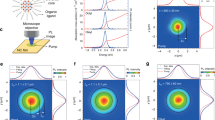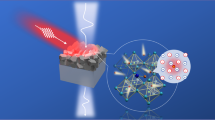Abstract
Prolonging the carrier lifetime in lead-halide perovskite (LHP) can enable novel schemes for highly efficient energy-harvesting and photodetection applications. However, suppressing the recombination processes in LHP without chemical treatments remains an open challenge. Here we show that the recombination rate of three-dimensional LHP polycrystalline thin films can decrease significantly when placed on hyperbolic metamaterials. Through momentum-resolved imaging, we reveal that these LHP films possess a dominant in-plane transition dipole, which in turn is responsible for the decrease in the recombination rate. We observe a decrease in the recombination rate of a MAPbI3 LHP thin film by ~50% and 30% when placed on a plasmonic mirror and a hyperbolic metamaterial, respectively. Furthermore, we discover a tenfold decrease in the recombination rate of (Cs0.06FA0.79MA0.15)Pb(I0.85Br0.15)3, and the origin of this giant reduction in the recombination process is discussed based on exciton-trapping dynamics. By controlling the recombination rate of LHPs, we demonstrate a 250% increase in photoresponsivity of LHP-based photodetectors. The resulting physical insights will provide novel means to enhance the efficiency of LHP-based optoelectronic and photonic devices.
This is a preview of subscription content, access via your institution
Access options
Access Nature and 54 other Nature Portfolio journals
Get Nature+, our best-value online-access subscription
$29.99 / 30 days
cancel any time
Subscribe to this journal
Receive 12 print issues and online access
$209.00 per year
only $17.42 per issue
Buy this article
- Purchase on Springer Link
- Instant access to full article PDF
Prices may be subject to local taxes which are calculated during checkout






Similar content being viewed by others
Data availability
The data that support the findings of this study are available from the corresponding author upon reasonable request.
References
Pelton, M. Modified spontaneous emission in nanophotonic structures. Nat. Photon. 9, 427–435 (2015).
Akselrod, G. M. et al. Probing the mechanisms of large Purcell enhancement in plasmonic nanoantennas. Nat. Photon. 8, 835–840 (2014).
Lu, D., Kan, J. J., Fullerton, E. E. & Liu, Z. Enhancing spontaneous emission rates of molecules using nanopatterned multilayer hyperbolic metamaterials. Nat. Nanotechnol. 9, 48–53 (2014).
Poddubny, A., Iorsh, I., Belov, P. & Kivshar, Y. Hyperbolic metamaterials. Nat. Photon. 7, 958–967 (2013).
Krishnamoorthy, H. N. S., Jacob, Z., Narimanov, E., Kretzschmar, I. & Menon, V. M. Topological transitions in metamaterials. Science 336, 205–209 (2012).
Purcell, E. M. Resonance absorption by nuclear magnetic moments in a solid. Phys. Rev. 69, 37–38 (1946).
Drexage, K. H. Influence of a dielectric interface on fluorescence decay time. J. Lumin. 1–2, 693–701 (1970).
Peter, Lodahl et al. Controlling the dynamics of spontaneous emission from quantum dots by photonic crystals. Nature 430, 654–657 (2004).
Elkabbash, M. et al. Cooperative energy transfer controls the spontaneous emission rate beyond field enhancement limits. Phys. Rev. Lett. 122, 203901 (2019).
Russell, K. J., Liu, T. L., Cui, S. & Hu, E. L. Large spontaneous emission enhancement in plasmonic nanocavities. Nat. Photon. 6, 459–462 (2012).
Yablonovitch, E. & Gmitter, T. J. Photonic band structure: the face-centered-cubic case. Phys. Rev. Lett. 63, 1950–1953 (1989).
Rogers, T. J., Deppe, D. G. & Streetman, B. G. Effect of an AlAs/GaAs mirror on the spontaneous emission of an InGaAs-GaAs quantum well. Appl. Phys. Lett. 57, 1858–1860 (1990).
Haroche, S. & Kleppner, D. Cavity quantum electrodynamics. Phys. Today 42, 24–30 (1989).
Barnes, W. L. Fluorescence near interfaces. J. Mod. Opt. 45, 661–699 (1998).
Brotons-Gisbert, M. et al. Out-of-plane orientation of luminescent excitons in two-dimensional indium selenide. Nat. Commun. 10, 3913 (2019).
Scott, R. et al. Directed emission of CdSe nanoplatelets originating from strongly anisotropic 2D electronic structure. Nat. Nanotechnol. 12, 1155–1160 (2017).
Wang, G. et al. In-plane propagation of light in transition metal dichalcogenide monolayers: optical selection rules. Phys. Rev. Lett. 119, 047401 (2017).
Schuller, J. A. et al. Orientation of luminescent excitons in layered nanomaterials. Nat. Nanotechnol. 8, 271–276 (2013).
Wang, X. et al. Highly anisotropic and robust excitons in monolayer black phosphorus. Nat. Nanotechnol. 10, 517–521 (2015).
DeCrescent, R. A. et al. Bright magnetic dipole radiation from two-dimensional lead-halide perovskites. Sci. Adv. 6, eaay4900 (2020).
Chuang, S. Y., Yu, C. C., Chen, H. L., Su, W. F. & Chen, C. W. Exploiting optical anisotropy to increase the external quantum efficiency of flexible P3HT:PCBM blend solar cells at large incident angles. Sol. Energy Mater. Sol. Cells 95, 2141–2150 (2011).
Böhmler, M. et al. Enhancing and redirecting carbon nanotube photoluminescence by an optical antenna. Opt. Express 18, 16443 (2010).
Yang, Y. et al. Observation of a hot-phonon bottleneck in lead-iodide perovskites. Nat. Photon. 10, 53–59 (2016).
Dong, Q. et al. Electron-hole diffusion lengths >175 μm in solution-grown CH3NH3PbI3 single crystals. Science 347, 967–970 (2015).
Giovanni, D. et al. Origins of the long-range exciton diffusion in perovskite nanocrystal films: photon recycling vs exciton hopping. Light Sci. Appl. 10, 1–9 (2021).
Hu, W. et al. Germanium/perovskite heterostructure for high-performance and broadband photodetector from visible to infrared telecommunication band. Light Sci. Appl. 8, 106 (2019).
Leung, S. F. et al. A self-powered and flexible organometallic halide perovskite photodetector with very high detectivity. Adv. Mater. 30, 1704611 (2018).
Saidaminov, M. I. et al. Planar-integrated single-crystalline perovskite photodetectors. Nat. Commun. 6, 8724 (2015).
Fang, Y., Dong, Q., Shao, Y., Yuan, Y. & Huang, J. Highly narrowband perovskite single-crystal photodetectors enabled by surface-charge recombination. Nat. Photon. 9, 679–686 (2015).
Lin, Q., Armin, A., Nagiri, R. C. R., Burn, P. L. & Meredith, P. Electro-optics of perovskite solar cells. Nat. Photon. 9, 106–112 (2015).
Jeon, N. J. et al. Compositional engineering of perovskite materials for high-performance solar cells. Nature 517, 476–480 (2015).
Huang, J. Resolving spatial and energetic distributions of trap states in metal halide perovskite solar cells. Science 367, 1352–1358 (2020).
Tan, Z. K. et al. Bright light-emitting diodes based on organometal halide perovskite. Nat. Nanotechnol. 9, 687–692 (2014).
Kim, Y. H., Cho, H. & Lee, T. W. Metal halide perovskite light emitters. Proc. Natl Acad. Sci. USA 113, 11694–11702 (2016).
Lin, K. et al. Perovskite light-emitting diodes with external quantum efficiency exceeding 20 per cent. Nature 562, 245–248 (2018).
Chamoli, S. K., ElKabbash, M., Zhang, J. & Guo, C. Dynamic control of spontaneous emission rate using tunable hyperbolic metamaterials. Opt. Lett. 45, 1671–1674 (2020).
Lee, K. J., Lee, Y. U., Kim, S. J. & André, P. Hyperbolic dispersion dominant regime identified through spontaneous emission variations near metamaterial interfaces. Adv. Mater. Interfaces 5, 1701629 (2018).
Tumkur, T. et al. Control of spontaneous emission in a volume of functionalized hyperbolic metamaterial. Appl. Phys. Lett. 99, 2011–2014 (2011).
Chen, X., Lu, H., Yang, Y. & Beard, M. C. Excitonic effects in methylammonium lead halide perovskites. J. Phys. Chem. Lett. 9, 2595–2603 (2018).
Saba, M. et al. Correlated electron–hole plasma in organometal perovskites. Nat. Commun. 5, 5049 (2014).
Yang, Y. et al. Large polarization-dependent exciton optical Stark effect in lead iodide perovskites. Nat. Commun. 7, 12613 (2016).
Lee, K. J. et al. Exciton dynamics in two-dimensional MoS2 on hyperbolic metamaterial-based nanophotonic platform. Phys. Rev. B 101, 041405(R) (2020).
Lee, K. J. et al. Blue-shifting intramolecular charge transfer emission by nonlocal effect of hyperbolic metamaterials. Nano Lett. 18, 1476–1482 (2018).
Lee, K. J. et al. Charge-transfer dynamics and nonlocal dielectric permittivity tuned with metamaterial structures as solvent analogues. Nat. Mater. 16, 722–730 (2017).
Barrit, D. et al. Impact of the solvation state of lead iodide on its two-step conversion to MAPbI3: an in situ investigation. Adv. Funct. Mater. 29, 1807544 (2019).
Syed, H. et al. Giant nonlinear optical response in triple cation halide mixed perovskite films. Adv. Opt. Mater. 8, 1901766 (2020).
Berberan-Santos, M. N., Bodunov, E. N. & Valeur, B. Mathematical functions for the analysis of luminescence decays with underlying distributions 1. Kohlrausch decay function (stretched exponential). Chem. Phys. 315, 171–182 (2005).
Alcocer, M. J. P., Leijtens, T., Herz, L. M., Petrozza, A. & Snaith, H. J. Electron-hole diffusion lengths exceeding trihalide perovskite absorber. Science 342, 341–344 (2013).
Shi, J. et al. Exciton character and high-performance stimulated emission of hybrid lead bromide perovskite polycrystalline film. Adv. Opt. Mater. 8, 1902026 (2020).
Abdi-Jalebi, M. et al. Maximizing and stabilizing luminescence from halide perovskites with potassium passivation. Nature 555, 497–501 (2018).
Goodman, A. J., Willard, A. P. & Tisdale, W. A. Exciton trapping is responsible for the long apparent lifetime in acid-treated MoS2. Phys. Rev. B 96, 121404(R) (2017).
Acknowledgements
This research was supported by the Bill and Melinda Gates Foundation, the Army Research Office, the National Science Foundation and the National Natural Science Foundation.
Author information
Authors and Affiliations
Contributions
K.J.L., M.E. and C.G. discussed and defined the project. K.J.L. and M.E. initiated the project and designed and coordinated the experiments. Y.W. characterized the optical properties of the samples. R.W. prepared the nanophotonic substrates and performed numerical calculations of absorption. K.J.L. and Y.W. performed TRPL measurements. K.J.L. and J.Z. carried out the radiation pattern measurements. S.K.C. and M.E. performed the Purcell factor calculations. W.K., T.H. and W.Y. carried out the photodetector experiment. K.J.L., M.E. and C.G. analysed the data. K.J.L., M.E. and C.G. wrote the manuscript. C.G. supervised the overall project. All authors commented on the paper.
Corresponding authors
Ethics declarations
Competing interests
The authors declare no competing interests.
Peer review
Peer review information
Nature Photonics thanks Takashi Asano, Matthew Pelton and the other, anonymous, reviewer(s) for their contribution to the peer review of this work.
Additional information
Publisher’s note Springer Nature remains neutral with regard to jurisdictional claims in published maps and institutional affiliations.
Supplementary information
Supplementary Information
Supplementary Figs. 1–18, notes I–VII and Tables 1–5.
Rights and permissions
Springer Nature or its licensor (e.g. a society or other partner) holds exclusive rights to this article under a publishing agreement with the author(s) or other rightsholder(s); author self-archiving of the accepted manuscript version of this article is solely governed by the terms of such publishing agreement and applicable law.
About this article
Cite this article
Lee, K.J., Wei, R., Wang, Y. et al. Gigantic suppression of recombination rate in 3D lead-halide perovskites for enhanced photodetector performance. Nat. Photon. 17, 236–243 (2023). https://doi.org/10.1038/s41566-022-01151-3
Received:
Accepted:
Published:
Issue Date:
DOI: https://doi.org/10.1038/s41566-022-01151-3



